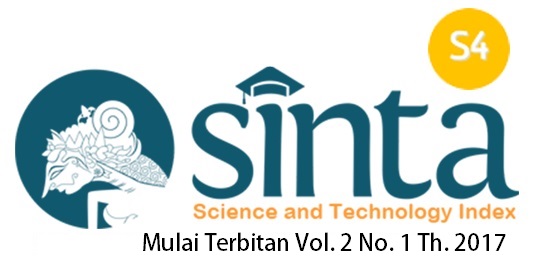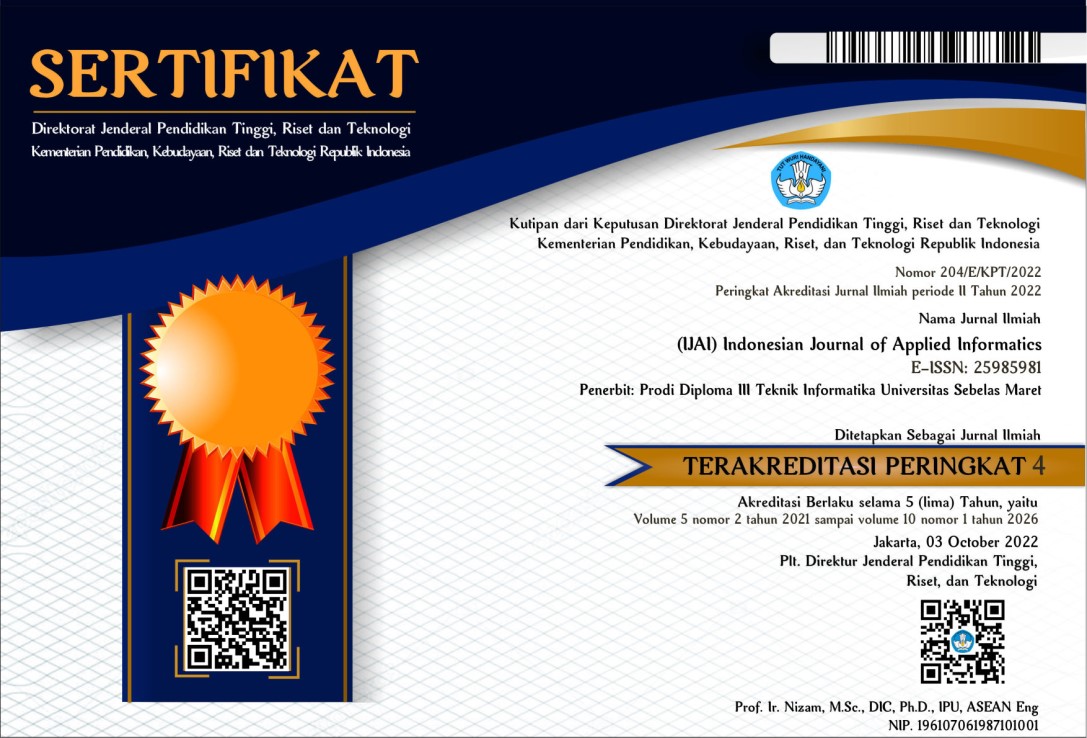Aplikasi Presensi Siswa Berbasis Location Based Services (LBS) Dengan Haversine Formula Di SMK Islam Al-Futuhiyyah
Abstract
Abstrak :
Perkembangan teknologi informasi membawa dampak signifikan di bidang pendidikan, termasuk dalam sistem presensi siswa. Penelitian ini bertujuan untuk mengembangkan aplikasi presensi siswa berbasis Android dengan menggunakan metode Location Based Services (LBS) di SMK Islam Al-Futuhiyyah. Metode yang digunakan adalah Research and Development (R&D) dengan model pengembangan perangkat lunak Waterfall, meliputi analisis kebutuhan, desain, implementasi, pengujian, dan evaluasi. Aplikasi ini menggunakan metode Haversine untuk mengukur jarak antara lokasi siswa dan lokasi sekolah, sehingga memastikan presensi dilakukan di area yang telah ditentukan. Hasil pengujian menunjukkan bahwa aplikasi ini berhasil memvalidasi presensi dengan akurasi tinggi, di mana Haversine Formula menghasilkan akurasi presensi hingga 100%. Pengujian Black Box memastikan semua fungsi aplikasi berjalan sesuai spesifikasi, sedangkan pengujian LBS membuktikan keakuratan dalam mendeteksi lokasi siswa. Selain itu, berdasarkan User Acceptance Testing (UAT) yang melibatkan siswa dan guru, aplikasi ini memperoleh skor kepuasan 81,7%. Aplikasi ini juga mempermudah siswa dalam melakukan presensi, sekaligus membantu guru dan operator sekolah dalam memantau dan mengelola data presensi. Implementasi aplikasi ini memberikan solusi efektif dan efisien untuk menggantikan metode presensi manual yang kurang praktis. Penelitian ini diharapkan dapat meningkatkan kualitas layanan pendidikan di SMK Islam Al-Futuhiyyah dan menjadi referensi bagi pengembangan sistem presensi berbasis teknologi di lembaga pendidikan lainnya
===================================================
Abstract :
The development of information technology has a significant impact on the field of education, including in the student attendance system. This study aims to develop an Android-based student attendance application using the Location Based Services (LBS) method at SMK Islam Al-Futuhiyyah. The method used is Research and Development (R&D) with the Waterfall software development model, including needs analysis, design, implementation, testing, and evaluation. This application uses the Haversine method to measure the distance between the student's location and the school location, thus ensuring that attendance is carried out in a predetermined area. The test results show that this application has successfully validated attendance with high accuracy, where the Haversine Formula produces attendance accuracy of up to 100%. Black Box testing ensures that all application functions run according to specifications, while LBS testing proves accuracy in detecting student locations. In addition, based on User Acceptance Testing (UAT) involving students and teachers, this application received a satisfaction score of 81,7% This application also makes it easier for students to take attendance, while helping teachers and school operators to monitor and manage attendance data. The implementation of this application provides an effective and efficient solution to replace the less practical manual attendance method. This research is expected to improve the quality of educational services at Al-Futuhiyyah Islamic Vocational School and become a reference for the development of technology-based attendance systems in other educational institutions.
Keywords
Full Text:
PDFReferences
[1] D. Hermawan, W. Wiyanto, and T. N. Wiyatno, “Penerapan Location Based Service(LBS) Pada Sistem Pencarian Kontrakan Dengan Metode Prototype,” Faktor Exacta, vol. 16, no. 1, Mar. 2023, doi: 10.30998/faktorexacta.v16i1.14991.
[2] I. Arfiani et al., “Penerapan Haversine Formula Pada Server Aplikasi Location Based Service Untuk Pencarian Lokasi Amal Usahamuhammadiyah,” Universitas Amikom Yogyakarta, 2018.
[3] A. W. Suryo and V. Nurlaily, “Penentuan Rute Terdekat Dengan Algoritma Haversine Menggunakan Location Based Service,” Jurnal Informatika Teknologi dan Sains (Jinteks), vol. 6, no. 1, pp. 46–51, Feb. 2024, doi: 10.51401/jinteks.v6i1.3811.
[4] L. N. Hayati, “Sistem Monitoring Karyawan Dengan Metode LBS (Location Based Service) Berbasis Android,” Online, 2019. [Online]. Available: http://jurnal.stiki-indonesia.ac.id/index.php/jurnalresistor
[5] J. Kuswanto and F. Radiansah, “Media Pembelajaran Berbasis Android Pada Mata Pelajaran Sistem Operasi Jaringan Kelas XI,” 2018.
[6] A. Sandro and E. C. D. Ririn, “Implementasi Global Positioning System (GPS) dan Location Based Service (LSB) pada Sistem Informasi Kereta Api untuk Wilayah Jabodetabek,” JURNAL SISFOTEK GLOBAL, vol. 7, pp. 27–33, 2017.
[7] N. Agustina, S. Risnanto, and I. Supriadi, “Pengembangan Aplikasi Location Based Service Untuk Informasi Dan Pencarian Lokasi Pariwisata Di Kota Cimahi Berbasis Android,” 2016. [Online]. Available: www.unikom.ac.id
[8] A. Harsa Kridalaksana, “Penerapan Formula Haversine Pada Sistem Informasi Geografis Pencarian Jarak Terdekat Lokasi Lapangan Futsal,” 2018.
[9] A. Aisyah, D. Permata Sari, and K. Kusumanto, “Perancangan Aplikasi Presensi Dosen Real Time dengan Metode Global Positioning System (GPS) dan Location Based Service (LSB) Berbasis WEB di Jurusan Teknik Elektronika Politeknik Negeri Sriwijaya,” Journal Locus Penelitian dan Pengabdian, vol. 1, no. 5, pp. 341–347, Aug. 2022, doi: 10.36418/locus.v1i5.73.
[10] J. Masini, A. Pranoto, and N. Vendyansyah, “Aplikasi Pencarian Spbu Mini Dan Bengkel Menggunakan Metode Location Based Service Pada Kecamatan Lowokwaru Malang Berbasis Android,” 2020.
[11] S. A. Hasbullah, “Aplikasi Pencari Tempat Pencucian Mobil Dan Motor Di Kota Malang Menggunakan Metode Location Based Service (LBS) Berbasis Android,” 2017.
[12] A. Fauzi, F. Pernando, and M. Raharjo, “Penerapan Metode Haversine Formula Pada Aplikasi Pencarian Lokasi Tempat Tambal Ban Kendaraan Bermotor Berbasis Mobile Android,” Jurnal Teknik Komputer, no. 2, pp. 56–63, 2018, doi: 10.31294/jtk.v4i2.3512.
[13] A. Dwinggo Samala et al., “Rancang Bangun Aplikasi E-Sertifikat Berbasis Web Menggunakan Metode Pengembangan Waterfall,” Jurnal Teknik Informatika, vol. 13, no. 2, 2020.
[14] W. Aliman, “Perancangan Perangkat Lunak untuk Menggambar Diagram Berbasis Android,” Syntax Literate ; Jurnal Ilmiah Indonesia, vol. 6, no. 6, p. 3091, Jun. 2021, doi: 10.36418/syntax-literate.v6i6.1404.
[15] K. ’ Afiifah, Z. Fira Azzahra, A. D. Anggoro, D. Redaksi, R. Akhir, and D. Online, “Analisis Teknik Entity-Relationship Diagram dalam Perancangan Database: Sebuah Literature Review,” JURNAL INTECH, vol. 3, no. 1, pp. 8–11, Mar. 2022.
[16] “Official U.S. government information about the Global Positioning System (GPS) and related topics,” GPS.gov. Accessed: Jan. 09, 2025. [Online]. Available: https://www.gps.gov/systems/gps/performance/accuracy/
[17] W. Nova Noor Kamala Sari, “Pemanfaatan Aplikasi Mobile Assistant Untuk Mendeteksi Kerumunan dalam Penerapan New Normal Covid-19,” Jurnal Komputer Terapan, vol. 7, no. 2, pp. 251–260, Nov. 2021, [Online]. Available: https://jurnal.pcr.ac.id/index.php/jkt/
[18] Devid Wijaya, Irwan, and Muhammad Setya Pratama, “Transformasi Digital Sekolah Taman Kanak-Kanak: Pengembangan Aplikasi Manajemen Presensi Guru Berbasis RFID,” TEKNIMEDIA: Teknologi Informasi dan Multimedia, vol. 5, no. 2, Dec. 2024, doi: 10.46764/teknimedia.v5i2.218.
Refbacks
- There are currently no refbacks.






